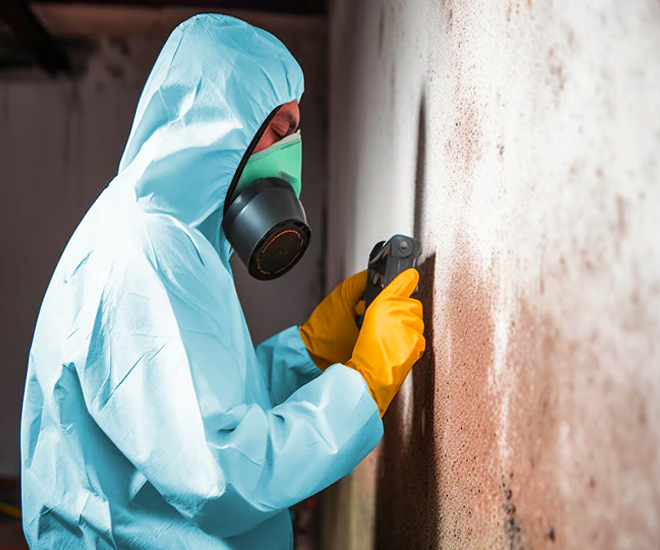Guaranteeing Post Remediation Verification Accuracy
Wiki Article
Professional Tips for Message Mold And Mildew Remediation Success
In the realm of mold remediation, effectively getting rid of mold is just half the battle; real obstacle lies in preventing its reappearance. Post-remediation efforts play an important duty in making sure a mold-free atmosphere in the lengthy term. By sticking to expert suggestions and ideal practices, people can protect their spaces versus mold renewal and keep a healthy and balanced interior environment. It is in this phase of the remediation process that interest to detail and positive steps genuinely make a difference.
Screen Moisture Degrees On A Regular Basis
After finishing mold remediation procedures, preserving optimum humidity levels is critical to avoid mold and mildew re-growth and ensure a healthy interior atmosphere. High moisture degrees over 60% create a conducive atmosphere for mold to prosper, making normal monitoring a positive step to avoid any type of future mold and mildew problems.Additionally, developing a routine timetable for humidity checks, particularly in high-risk locations such as bathrooms, cellars, and cooking areas, is an aggressive technique to mold avoidance. By continually monitoring moisture levels, residential or commercial property owners can properly minimize the danger of mold reoccurrence and maintain a healthy interior setting post-remediation.
Conduct Thorough Inspections Post-Remediation
Complying with the conclusion of mold remediation treatments, it is imperative to conduct extensive inspections to confirm the effectiveness of the removal process. These post-remediation inspections are critical in making sure that the mold and mildew concern has actually been successfully attended to which there is no reappearance or continuing to be mold and mildew growth. Evaluations must be accomplished by qualified experts that have expertise in identifying mold and examining interior air quality.During these assessments, numerous approaches such as aesthetic analyses, air sampling, and surface area tasting might be used to extensively evaluate the remediated areas. Visual assessments involve an in-depth inspection of the facilities to inspect for any kind of visible signs of mold development or water damage. Air sampling aids in identifying the airborne mold spore levels, while surface area sampling can detect mold particles on surface areas.
Implement Appropriate Ventilation Methods
After making certain the efficiency of the mold removal process through extensive assessments, the next critical action is to concentrate on carrying out correct ventilation methods. Adequate ventilation is crucial in avoiding mold and mildew reoccurrence by managing dampness degrees and promoting air flow.
Correct air flow not only aids in stopping mold and mildew development yet also contributes to the overall health and comfort of residents. By ensuring adequate ventilation throughout the home, you can minimize the Website threat of mold regrowth and develop a healthier living atmosphere.

Use Mold-Resistant Products for Repairs
To boost the long-lasting effectiveness of mold and mildew removal efforts, integrating mold-resistant products for repair work is vital in reducing the risk of future mold and mildew growth. Mold-resistant products are designed to stand up to moisture and inhibit mold growth, making them a necessary selection for locations susceptible to moisture and humidity. When fixing areas affected by mold and mildew, making use of products such as mold-resistant drywall, mold-resistant paints, and mold-resistant caulking can assist avoid mold and mildew reoccurrence.Mold-resistant drywall is an exceptional option to typical drywall in locations like cellars and shower rooms where dampness degrees are higher. This kind of drywall has a special covering that withstands mold growth even when subjected to damp conditions. Additionally, using mold-resistant paints consisting of antimicrobial agents can better inhibit mold development on walls and ceilings.
In locations where moisture prevails, such as kitchen areas and restrooms, using mold-resistant caulking around sinks, windows, and bathtubs can assist seal out water and protect against mold and mildew from holding in fractures and gaps. By buying these mold-resistant products during repair services post-remediation, you can substantially decrease view website the probability of future mold and mildew issues and keep a much healthier indoor atmosphere.
Maintain Tidiness and Address Water Issues
After mold and mildew remediation, it is crucial to preserve a tidy atmosphere to avoid the regrowth of mold and mildew. Leaks, water invasion, or high moisture degrees can create the ideal reproduction ground for mold, so it is vital to take care of any type of water-related troubles promptly.To preserve cleanliness, take into consideration utilizing HEPA filters in vacuums and air cleansers to trap mold spores and stop their blood circulation in the air. Moreover, making certain correct air flow in locations vulnerable to moisture build-up, such as restrooms and cooking areas, can help keep humidity degrees in check. By remaining cautious regarding cleanliness and resolving water issues quickly, you can efficiently prevent mold reinfestation and keep a healthy and balanced interior setting.
Final Thought

In the world of discover here mold and mildew removal, successfully eliminating mold is only half the battle; the real difficulty exists in avoiding its reappearance. After finishing mold and mildew remediation treatments, maintaining optimal humidity levels is critical to protect against mold and mildew re-growth and ensure a healthy interior environment. High humidity degrees above 60% produce a conducive setting for mold to grow, making regular checking a positive step to prevent any type of future mold and mildew problems.
To improve the lasting effectiveness of mold and mildew remediation initiatives, incorporating mold-resistant materials for repair work is critical in minimizing the risk of future mold growth. After mold removal, it is important to maintain a clean environment to protect against the regrowth of mold and mildew.
Report this wiki page